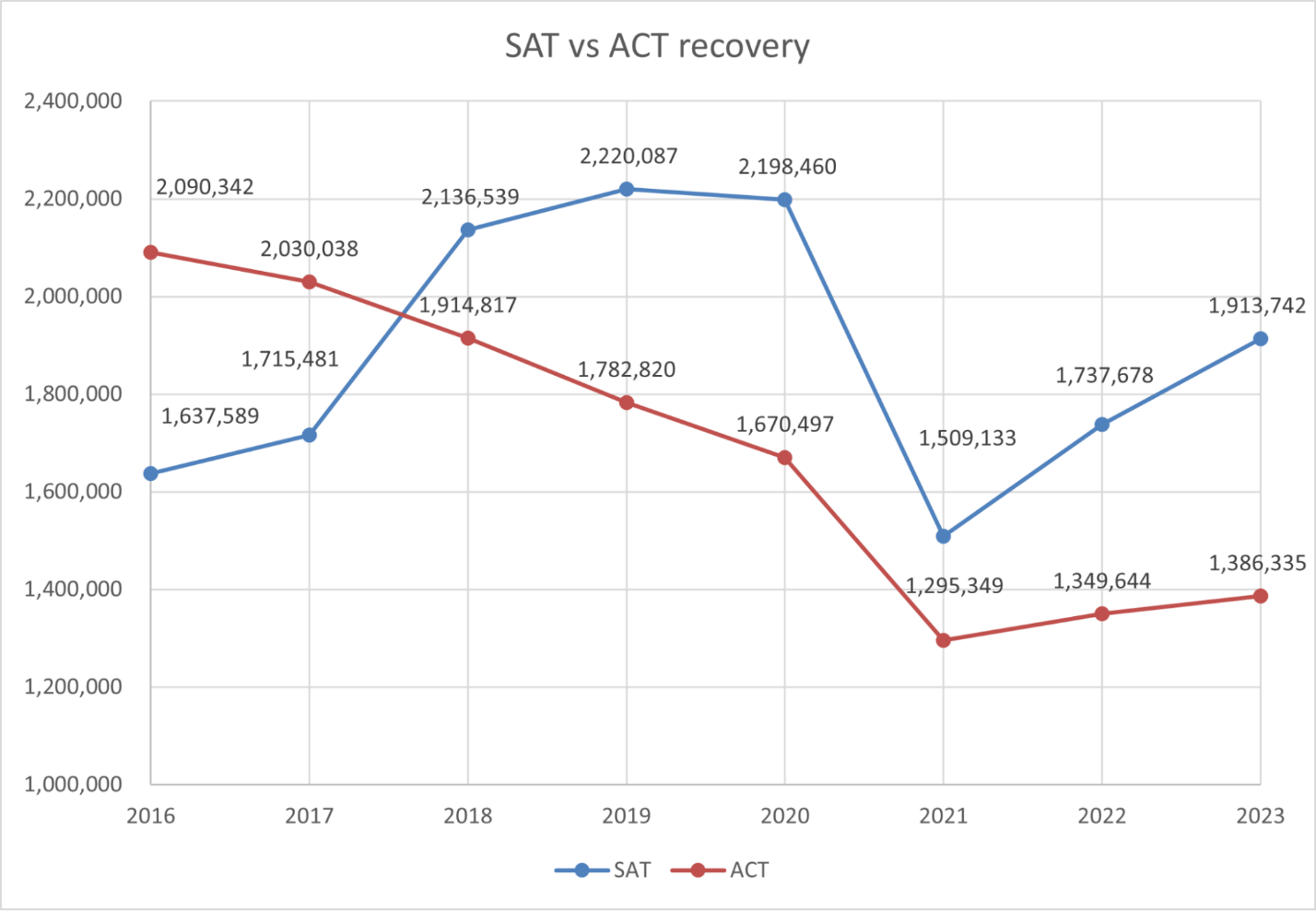ESM Welcomes College MatchPoint to the Team! Learn More

ACT, Inc. recently announced an option for students to take a shorter digital version of the ACT during the June 2024 administration. Does this indicate larger changes ahead for the ACT, and if so, what might they look like?
ACT, Inc., parent company of the ACT test, has been struggling, losing market share, and falling behind the College Board. With this loss in popularity, it’s clear that waiting on the sidelines, while the College Board overhauls its flagship test to become a more student-friendly assessment, has not been a successful strategy. While the ACT has a whopping 215 questions, a testing time of 2 hours and 55 minutes and 48.8 seconds/question, the digital adaptive SAT has a mere 98 questions, a testing time of 2 hours and 14 minutes, and 82 seconds per question. In terms of timing per question, the SAT gives students 68% more time per question. That’s a big deal. It’s no surprise that many students now prefer the length and pacing of the SAT.

It appears the ACT is finally acknowledging it must adapt to the times and preferences of students. Students signing up for the June ACT now have the option of signing up for the chance to take an ACT with fewer questions, and more time per question. Here’s the link to the announcement of the June 2024 study, billed as “a chance to take a shorter test!” Note that students “will be randomly assigned a test form with one of two timing conditions: either the full ACT, or a version with fewer questions and reduced time per section.” Students will not know which version they will receive until test day.
The ACT has given no indication whether or not this new testing form will be an adaptive test form, like the SAT, or a conventional test form, using classical test theory. The only way to dramatically reduce the number of items and still arrive at a reliable and valid score is through the adoption of item response theory, a foundation of adaptive testing. Potentially ACT, Inc. is looking to merely trim the number of items, slightly reducing the problem set per section, without a radical overhaul of its test. We will know more after June, or after any announcement from the test developers—and rest assured, we will let you know!
If you’ve been following the “testing wars” over the last decade or so, you’ll know that the ACT was the early and clear leader in the race towards digital and digital adaptive testing. I covered the story in 2013, when the ACT announced the forthcoming digital delivery of the ACT, which was meant to become optional for students around 2015. This option didn’t emerge for individual students until last year, 8 years behind schedule.
Many years ago, hundreds of thousands of students in the 8th grade took the ACT Explore test and greater numbers of 10th grade students took the ACT PLAN. In 2013, sixteen states had contracts for statewide Explore and PLAN testing. ACT, Inc. decided to bring all of those students into the digital world with the advent of the ACT Aspire test in the spring of 2014. ACT, Inc. charged a premium for a paper option, and pushed schools and states to go digital. The rollout was buggy and demand fell off a cliff. Only one state, Alabama, renewed its statewide contract. In time the ACT returned to its paper-based PreACT offerings, but the damage had been done.
Under newly minted CEO Marten Roorda, ACT, Inc. began offering its digital, non-adaptive test, to schools, districts and states in 2016. At that time, the ACT reigned supreme, and had taken market share from the SAT with its more Common-Core aligned assessment, and its rapid growth in statewide ACT contracts (in spite of losing Explore and Plan contracts following the launch of the Aspire). Meanwhile, the College Board, under the new leadership of David Coleman, was retooling the SAT to better align with the Common Core State Standards, in efforts to win more state-contracts and squeeze out the ACT.
In October 2016, I spoke with Marten Roorda at a national conference, and he affirmed that in time, every single test the ACT, Inc. offered would be digital and adaptive. ACT, Inc. went on a buying spree, acquiring companies with expertise in the realm of digital assessment including Open Ed and Pacific Metrics, combining these entities to form the ACT Assessment Technologies Group. ACT, Inc. was gearing up for the digital adaptive future of testing.
Roorda was planning on migrating the ACT to a digital adaptive format in 2018, but then announced in August 2017 that plan would be pushed back. Meanwhile, the redesigned SAT was picking up steam, and gobbling up more state contracts.
In 2017 and 2018, cheating scandals rocked the testing world as the flaws in paper-tests became more and more apparent. Entire countries had to cancel all of their tests after security breaches. I wrote about the need to quickly move to digital adaptive tests to solve the issue. On October 2, 2018, cheating hit the domestic market and the ACT had to cancel a school-day test that had been leaked. Roorda promised to fix the problem with digital adaptive testing, a much more secure format, relatively immune to testing-leaks.
The international rollout of a digital adaptive ACT was slated for the fall of 2018, but the test-makers pulled back on the adaptive piece and simply forced every international student to take digital, non-adaptive tests in September of 2018. The rollout was not without its hiccups, and one of the challenges was the relative shortage of computers, as students were not allowed to use their own devices.
Meanwhile, Roorda continued his acquisition spree, and purchased an early AI company to facilitate automatic item generation for digital adaptive ACT tests. Roorda said within three years the ACT, Inc, could generate a unique test for each student at the touch of a button.
In 2019, ACT announced some student friendly changes: a digital testing option to arrive in September 2020, as well as sectional retesting for students. Students, and tutors, were excited by the prospect of sectional retesting on a digital platform. The pandemic hit in March, and all plans for testing changes were put on hold.
When the pandemic hit, and lockdowns began, testing companies were bleeding cash and clearly in trouble. They scrambled to figure out how to offer their assessments, and drive in the revenue to keep the companies afloat. ACT announced it was pushing back sectional testing while it focused on its core business. Money was drying up, and in May 2020, Roorda was replaced by the COO, Janet Godwin. Her mission: stay the course, cut costs, and get through the crisis. ACT offered seven test dates in September and October to get kids back into the testing pipeline, while postponing any implementation of an at-home ACT.
In 2022, after things had stabilized and ACT, Inc. was back in the black, Godwin announced that sectional testing was dead, after it failed to gain traction or acceptance among colleges. She also announced that when it comes to the ACT, “We will always have an option for paper.” This was a rejection of her predecessor’s drive to migrate all tests to a digital adaptive format. She was going to play conservative and not force any changes that might be unpopular. However, this didn’t address the massive issue that paper-based assessments have inherent security flaws. There hasn’t been a leak since 2018, but it doesn’t mean that couldn’t easily happen again. Paper is a problem for many reasons.
The ACT began gaining some traction with its digital ACT product as districts and even states began locking down contracts. However, the pricing to shift to digital is not particularly compelling. A district buying a paper ACT pays $53 per test, compared to $51.75 for a digital test. Next year the discount for digital testing will increase by a mere 50 cents.
That said, the digital test does offer increased scheduling flexibility for schools. This coming fall, paper ACTs can be given during the school day only on October 15 or 29, while digital ACTs can be given October 15-18, 21-25, October 29-November 1, or November 4-8. The ability to push a greater variety of digital test forms allows more flexibility. But unlike administering the digital SAT, with the ACT, schools still have to provide the computers, which is a limiting factor.
With its revenue nowhere near the pre-pandemic days, ACT, Inc. began laying off employees and reducing its office footprint in Iowa City. Additionally, ACT, Inc. began to offer “Buy One, Get One” ACT testing for the December ACT. On top of this, the ACT began to promote $5 discounts for ACT administrations that you could use or gift to others.
In short, ACT, Inc. began to look desperate. It had lost its innovative edge, abandoned its plans to offer sectional testing, and was waiting to see if the College Board made a mess of the digital adaptive migration. But the College Board has succeeded in migrating international students and now all US students to a digital format that is turning out to be more popular than the old paper test.
With the announcement of a shorter, less-speedy pilot test, it seems the ACT is finally getting back towards the innovative track it abandoned several years ago. While the ACT lost its edge, and ceded ground to the SAT, there’s no reason it cannot return to a place of greater prominence. Many students still prefer many aspects of the ACT, particularly the lower reading level, and if the test ends up shorter, and kids feel less rushed, that could turn out to be wind in the sails of the ACT.